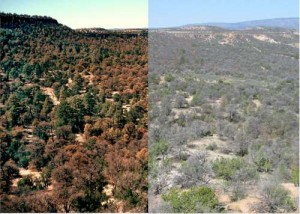The extended and severe drought in the southwestern United States has had many impacts on agriculture as well as water supply and ecosystems across the region. Some of them have been discussed previously in this blog.
This week, Rolling Stone magazine published an extensive article which discussed the impacts of the record-setting Western heat on tree physiology and forest health. In the article, scientists discuss how excessive heat shuts down the pumping of water through the tree, wilting or starving it. They also discuss how forests on Earth are already stressed not only from the recent warmer temperatures but also from increases in pests and diseases. They worry that much of the Southwest may eventually lose its forests and become shrubland.
This research has implications for the forests of the Southeast as well, since temperatures here have also risen since the 1970s in tandem with temperatures in other parts of the world. In the article, one scientist points out that forests notice even a one-degree change in temperature. Ranges of species may move and the mixes of species may also change over time. The water stress may be reduced somewhat by increased water efficiency from increased carbon dioxide but it is not clear how much of a benefit this would be.
The figure below (from a USGS publication on drought planning) shows the impact of one drought on a pinon pine forest in New Mexico as trees first turned reddish from stress and then dropped all their needles under worsening drought conditions.
